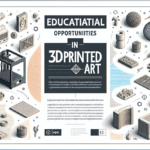Exploring 3D Printed Art Projects: Unleashing Creativity with Technology

Merging Art with Technology
In the 21st century, technological advancements have significantly influenced various forms of art, reshaping the way artists approach their creative processes. Among these advancements, 3D printing has emerged as a groundbreaking tool, enabling artists to produce works that transcend traditional limitations. By combining precision, customization, and accessibility, 3D printing fosters innovation, allowing creators to explore uncharted territories of design and expression.
The year 2024 has seen an explosion of interest in 3D printed art. Artists are not only embracing the technology for its practical applications but also as a medium of exploration and experimentation. This article delves into the world of 3D printed art projects, examining trends, tools, notable works, and the challenges faced by contemporary artists.
What Makes 3D Printed Art Unique?
The Basics of 3D Printed Art
3D printed art is a creative process where objects are designed digitally and then brought to life through additive manufacturing. This technique involves building an object layer by layer, allowing intricate designs that would be nearly impossible using traditional methods.
Key Features of 3D Printed Art:
- Precision: The technology facilitates high levels of detail, offering artists control over minute aspects of their designs.
- Material Diversity: Artists can work with a wide range of materials, including plastics, resins, and even metals.
- Customization: Every piece can be uniquely tailored, enabling bespoke creations.
How 3D Printing is Revolutionizing Artistic Expression
Artistic expression has traditionally been shaped by the materials and tools available to creators. With 3D printing, the possibilities are nearly limitless. Artists can experiment with new forms, textures, and dimensions, resulting in works that challenge conventional norms.
Moreover, the ability to prototype quickly and efficiently enables iterative design processes, encouraging creators to refine their concepts. The result is a harmonious blend of creativity and engineering that brings artistic visions to life.
2024 Trends in 3D Printed Art
In 2024, 3D printed art is at the forefront of artistic innovation. Several trends have emerged, highlighting the versatility and potential of this technology.
1. Eco-Friendly Materials
Sustainability has become a critical concern for artists and consumers alike. The availability of biodegradable filaments and recycled materials has enabled eco-conscious creators to minimize their environmental footprint. Artists are also exploring innovative materials such as algae-based resins and plant-based filaments, ensuring that their works are both beautiful and sustainable.
2. Large-Scale Installations
Advances in large-format 3D printers have unlocked new possibilities for creating expansive art installations. These printers can produce sizeable, seamless components that are assembled into towering sculptures or immersive environments. Public art projects, in particular, have benefited from this capability, transforming urban spaces into interactive artistic experiences.
3. Hybrid Creations
Artists are increasingly merging 3D printing with traditional techniques like painting, woodworking, and metal sculpting. This approach results in hybrid artworks that celebrate the interplay between modern technology and time-honored craftsmanship. For example, a sculpture may start as a 3D printed form but then be painted by hand or have metal elements integrated, blending the precision of technology with the tactile beauty of traditional art forms.
4. AI-Assisted Design
Artificial intelligence (AI) has become a powerful tool in the creative process. In 2024, artists are using AI to generate complex patterns and designs, which are then printed to create pieces that are both futuristic and visually compelling. AI-driven design not only saves time but also inspires new artistic directions. The technology is used to adapt designs dynamically, responding to environmental factors or user interactions.
Iconic 3D Printed Art Projects
Digital Blossoms by Emily Chen
This project explores the harmony between technology and nature through a series of floral sculptures. Made from biodegradable filaments, the pieces are designed to mimic organic forms while emphasizing sustainability. The project highlights the intersection of environmental concerns and technological innovation, showcasing how 3D printing can be used to make a statement about nature in the modern age.
Urban Reflections by Miguel Santos
A thought-provoking collection of 3D printed mirrors installed in urban areas. The mirrors invite viewers to reflect on their environment, blending functional art with social commentary. By using reflective surfaces, Santos’s work draws attention to the modern urban landscape, suggesting a sense of disconnect between individuals and their surroundings. This installation prompts viewers to reconsider their role in shaping the city’s visual identity.
The Living Ocean by Studio AquaForm
A captivating exhibition featuring marine-inspired sculptures printed from recycled ocean plastic. The project raises awareness about marine conservation while showcasing the potential of 3D printing to address environmental challenges. These sculptures, designed to evoke the beauty of the ocean, simultaneously serve as a commentary on the global plastic pollution crisis, reinforcing the idea that art can drive positive change.
How to Begin Your Journey into 3D Printed Art
Step 1: Understanding the Tools
Printers: Selecting the right 3D printer is crucial. Beginners might opt for budget-friendly models like the Creality Ender 3, while professionals may prefer advanced options such as the Formlabs Form 3 or Ultimaker S5. Each printer has its capabilities, from print size to material compatibility, which influences the type of art projects one can create.
Software: 3D modeling software is the foundation of any project. Popular choices include:
- TinkerCAD: Ideal for beginners due to its intuitive interface and free access.
- Blender: Offers advanced capabilities for experienced users who want to create highly detailed models.
- Fusion 360: A versatile tool for intricate designs and engineering applications, often used for creating functional art objects.
Materials: Artists can choose from various materials, each suited for different purposes. PLA (polylactic acid) is widely used for its ease of use and eco-friendliness, while ABS (acrylonitrile butadiene styrene) provides greater durability. Other materials include resin, which is commonly used for fine details, and flexible filaments for creating more dynamic sculptures.
Step 2: Designing and Prototyping
The creative process begins with translating ideas into digital designs. Artists often sketch concepts before using software to model the object in 3D. Many programs offer pre-made templates to help beginners experiment with basic shapes and forms.
Tips for Designing:
- Focus on simple structures and build complexity gradually.
- Take advantage of tutorials or online communities where designers share tips and techniques.
- Consider the final size of the piece and the constraints of your 3D printer.
Step 3: Printing and Finishing
Once the design is finalized, it’s sent to the printer. After printing, artists can refine their works through post-processing techniques such as sanding, painting, or adding additional elements to enhance visual appeal. This can include integrating textures or adding lighting features for an interactive experience.
Overcoming Challenges in 3D Printed Art
1. Learning Curve
For many artists, the technical aspects of 3D printing—such as mastering software or troubleshooting hardware—can be intimidating. Online tutorials, workshops, and forums provide invaluable support, making the technology more approachable.
Tips for Overcoming the Learning Curve:
- Start small with simple projects before attempting complex sculptures.
- Take online courses or attend workshops specifically designed for artists.
- Join online communities like Reddit’s 3D Printing Art, where artists can exchange knowledge and troubleshooting tips.
2. Financial Constraints
The cost of equipment and materials can be a barrier for emerging artists. Fortunately, affordable options are becoming increasingly available, and crowdfunding platforms offer opportunities to raise funds for larger projects.
Cost-Saving Tips:
- Opt for affordable filament materials like PLA to begin with.
- Look for used or refurbished printers that still offer high-quality results.
- Consider collaborative projects, where costs and resources are shared among artists.
3. Environmental Impact
Despite the availability of eco-friendly materials, waste generated during the printing process remains a concern. By optimizing designs and using sustainable materials, artists can minimize their environmental footprint.
Eco-Friendly Practices:
- Use biodegradable filaments such as PLA or PHA for sculptures.
- Recycle old prints or use scraps in future designs.
- Explore 3D printing with recycled materials or ocean plastics to create art with a message.
Educational Opportunities in 3D Printed Art
In 2024, many art institutions and programs are integrating 3D printing into their curricula. Students gain hands-on experience with cutting-edge technology, learning to balance technical skills with creative thinking. This education equips the next generation of artists with tools to navigate an increasingly digital art landscape.
Programs like those at the Rhode Island School of Design (RISD) and Pratt Institute offer specialized courses in digital fabrication and 3D modeling, encouraging students to explore new media.
Future Directions for 3D Printed Art
As technology continues to advance, the future of 3D printed art looks promising. Emerging trends include:
- Increased Accessibility: Affordable, user-friendly printers will enable more artists to explore 3D printing.
- Sustainable Practices: Innovations in material science will lead to greener solutions, such as 3D printing with biodegradable plastics and recycled materials.
- Interactive Art: The integration of electronics and sensors will bring interactive 3D printed art to life, allowing audiences to engage with the pieces in real-time.
FAQs
1. Can beginners create 3D printed art? Yes, with the availability of user-friendly software and affordable printers, beginners can start exploring 3D printed art with minimal barriers.
2. What materials are best for 3D printed art? PLA is ideal for beginners due to its ease of use and eco-friendliness. Advanced artists may experiment with resin, metal, or hybrid materials.
3. Is 3D printing expensive? While professional-grade equipment can be costly, there are budget-friendly options for hobbyists and emerging artists.
4. How sustainable is 3D printed art? Using biodegradable or recycled materials can make 3D printed art a sustainable practice. Artists are also exploring innovative ways to reduce waste.
5. What types of art can be created with 3D printing? From sculptures and jewelry to large-scale installations, 3D printing accommodates a wide range of artistic expressions.
Embracing Creativity with Technology
The intersection of 3D printing and art offers a compelling glimpse into the future of creativity. By leveraging cutting-edge technology, artists are not only redefining their craft but also inspiring audiences with works that challenge traditional boundaries. As accessibility and innovation continue to grow, 3D printed art will remain a dynamic force in shaping the artistic landscape of tomorrow.
Visit our other website: https://synergypublish.com





